Analyzing HRM Strategies: A Case Study of Maruti Suzuki India Limited
VerifiedAdded on 2023/07/11
|35
|5370
|212
Case Study
AI Summary
This case study provides an overview of Human Resource Management (HRM) practices at Maruti Suzuki India Limited, focusing on the people dimension in management and its impact on organizational objectives. It highlights the significance of HRM in employee satisfaction, performance improvement, and competitive advantage. The study covers the objectives of HRM, including setting employee goals, motivating performance, and facilitating professional growth, while also addressing the need for performance appraisals to identify strengths and weaknesses. The methodology involves data collection through surveys and statistical tools like pie charts and tables. Limitations of the study, such as appraiser bias and insufficient evidence, are acknowledged. Furthermore, the case study includes an industry profile of the Indian automobile sector and a company profile of Maruti Suzuki, detailing its mission, vision, history, and market position. Desklib provides access to this case study along with a wealth of study tools and resources for students.

INTRODUCTION
Human Resource Management is concerned with the people dimension in management since
every organization is made up of people acquiring their services developing their skills
motivating them to achieve a higher level of performance & ensuring that they continue their
commitment to the organization & which is essential in achieving an organizational objective.
This is true regardless of the type of organization, Government, education, health, recreation,
or social action. H.R.M. is planning, organizing, Directing, Controlling, developing,
compensation, integration, maintenance & separating HR to the end that individual &
organizational & social objectives are accomplished. Thus H.R.M refers to a set program,
function & activities designed & carried out in order to maximize both employee as well as
organizational effectiveness.
Meaning:
Human resource management is a management function that helps the manager to recruit
select, train, and develop members of the organization Because human force acts as the heart
of an organization without human organization cannot achieve its predetermined goals. In
fact, H.R.M. is a management function concerned with hiring and motivating & maintaining
people in the organization.
Definition:
“H.R.M is a series of integrated decisions that form of employment relation the quality
contributes to the organization while employees to achieve their objectives.”
Significance:
H.R.M. plays a crucial role in employee satisfaction, improving performance and
productivity. This helps in the organization’s competitive advantage, and it contributes to the
organization’s success. Every organization starts with a vision that their business, the priority
is to hire a competent workforce means the right person in the right place and the right time.
Human Resource Management is concerned with the people dimension in management since
every organization is made up of people acquiring their services developing their skills
motivating them to achieve a higher level of performance & ensuring that they continue their
commitment to the organization & which is essential in achieving an organizational objective.
This is true regardless of the type of organization, Government, education, health, recreation,
or social action. H.R.M. is planning, organizing, Directing, Controlling, developing,
compensation, integration, maintenance & separating HR to the end that individual &
organizational & social objectives are accomplished. Thus H.R.M refers to a set program,
function & activities designed & carried out in order to maximize both employee as well as
organizational effectiveness.
Meaning:
Human resource management is a management function that helps the manager to recruit
select, train, and develop members of the organization Because human force acts as the heart
of an organization without human organization cannot achieve its predetermined goals. In
fact, H.R.M. is a management function concerned with hiring and motivating & maintaining
people in the organization.
Definition:
“H.R.M is a series of integrated decisions that form of employment relation the quality
contributes to the organization while employees to achieve their objectives.”
Significance:
H.R.M. plays a crucial role in employee satisfaction, improving performance and
productivity. This helps in the organization’s competitive advantage, and it contributes to the
organization’s success. Every organization starts with a vision that their business, the priority
is to hire a competent workforce means the right person in the right place and the right time.
Paraphrase This Document
Need a fresh take? Get an instant paraphrase of this document with our AI Paraphraser

Objective
Human Resource Management helps a company to achieve its objective from time to time by
creating a positive attitude among workers. Reducing wastage and making maximum use of
resources etc.
Facilitates professional growth
Due to proper Human Resource policies employees are trained well and this makes them
ready for future promotions. Their talent can be utilized not only in the company in which
they are currently working but also in other companies which the employees may join in the
future.
Human Resource Management helps a company to achieve its objective from time to time by
creating a positive attitude among workers. Reducing wastage and making maximum use of
resources etc.
Facilitates professional growth
Due to proper Human Resource policies employees are trained well and this makes them
ready for future promotions. Their talent can be utilized not only in the company in which
they are currently working but also in other companies which the employees may join in the
future.
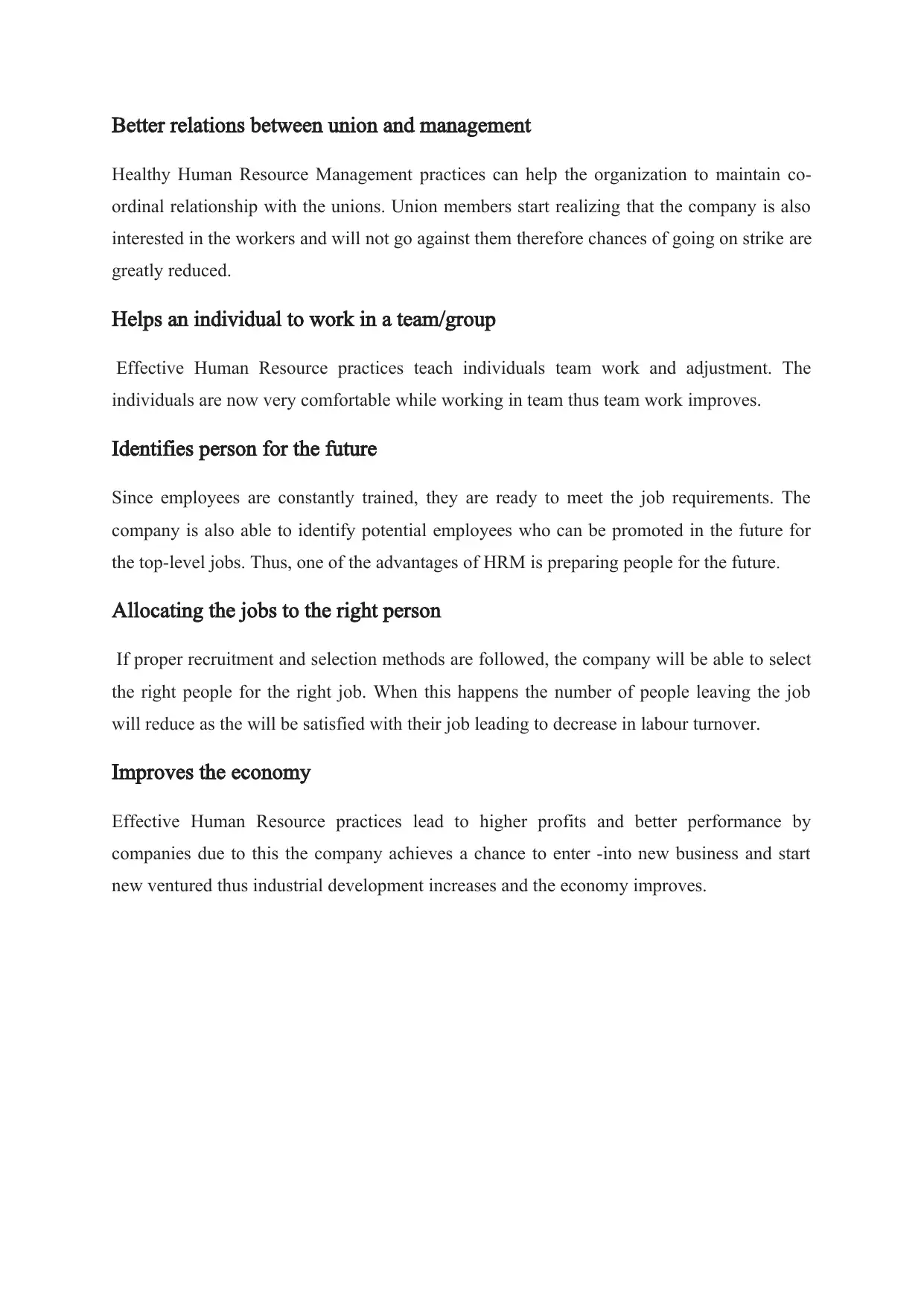
Better relations between union and management
Healthy Human Resource Management practices can help the organization to maintain co-
ordinal relationship with the unions. Union members start realizing that the company is also
interested in the workers and will not go against them therefore chances of going on strike are
greatly reduced.
Helps an individual to work in a team/group
Effective Human Resource practices teach individuals team work and adjustment. The
individuals are now very comfortable while working in team thus team work improves.
Identifies person for the future
Since employees are constantly trained, they are ready to meet the job requirements. The
company is also able to identify potential employees who can be promoted in the future for
the top-level jobs. Thus, one of the advantages of HRM is preparing people for the future.
Allocating the jobs to the right person
If proper recruitment and selection methods are followed, the company will be able to select
the right people for the right job. When this happens the number of people leaving the job
will reduce as the will be satisfied with their job leading to decrease in labour turnover.
Improves the economy
Effective Human Resource practices lead to higher profits and better performance by
companies due to this the company achieves a chance to enter -into new business and start
new ventured thus industrial development increases and the economy improves.
Healthy Human Resource Management practices can help the organization to maintain co-
ordinal relationship with the unions. Union members start realizing that the company is also
interested in the workers and will not go against them therefore chances of going on strike are
greatly reduced.
Helps an individual to work in a team/group
Effective Human Resource practices teach individuals team work and adjustment. The
individuals are now very comfortable while working in team thus team work improves.
Identifies person for the future
Since employees are constantly trained, they are ready to meet the job requirements. The
company is also able to identify potential employees who can be promoted in the future for
the top-level jobs. Thus, one of the advantages of HRM is preparing people for the future.
Allocating the jobs to the right person
If proper recruitment and selection methods are followed, the company will be able to select
the right people for the right job. When this happens the number of people leaving the job
will reduce as the will be satisfied with their job leading to decrease in labour turnover.
Improves the economy
Effective Human Resource practices lead to higher profits and better performance by
companies due to this the company achieves a chance to enter -into new business and start
new ventured thus industrial development increases and the economy improves.
⊘ This is a preview!⊘
Do you want full access?
Subscribe today to unlock all pages.

Trusted by 1+ million students worldwide
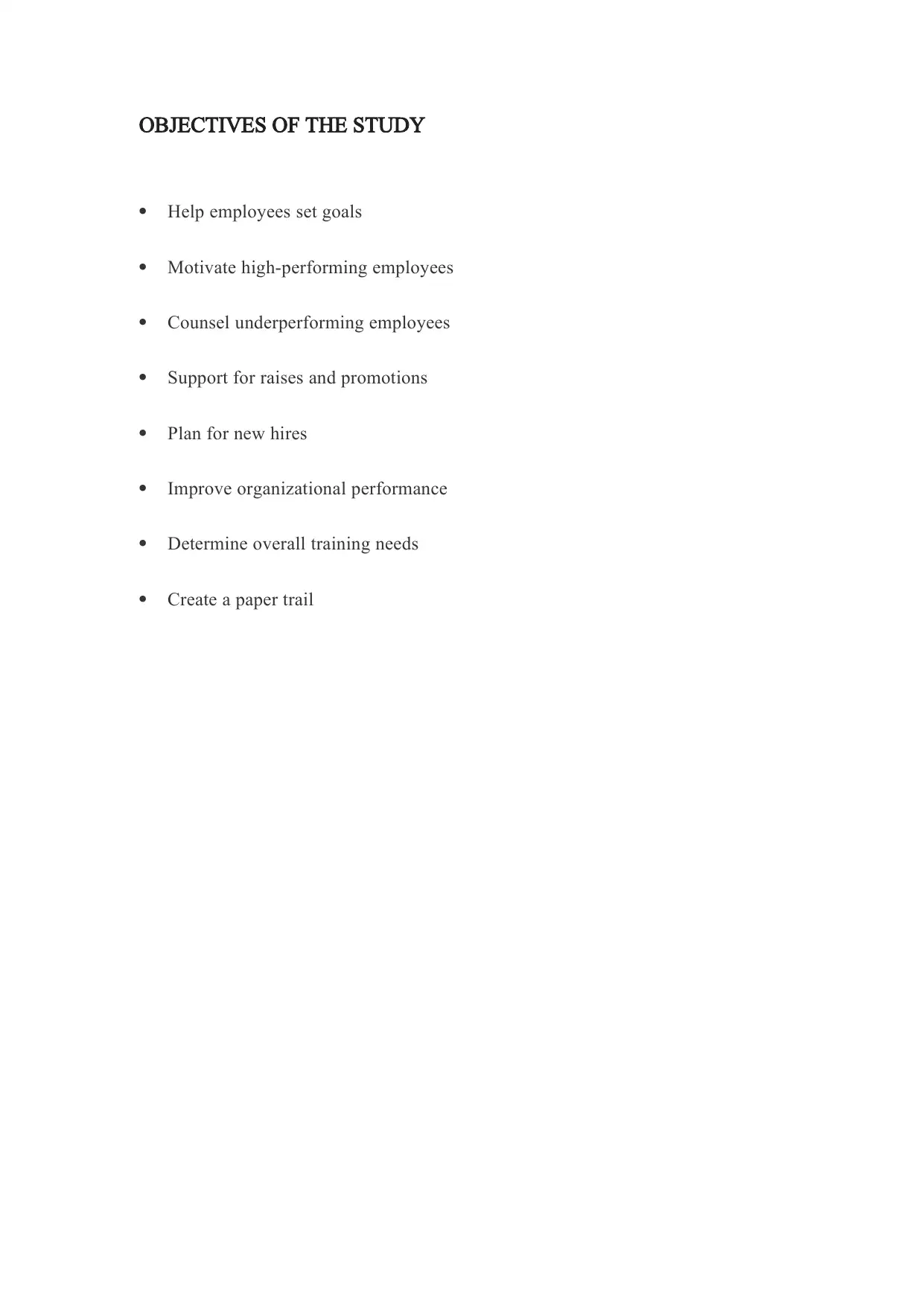
OBJECTIVES OF THE STUDY
Help employees set goals
Motivate high-performing employees
Counsel underperforming employees
Support for raises and promotions
Plan for new hires
Improve organizational performance
Determine overall training needs
Create a paper trail
Help employees set goals
Motivate high-performing employees
Counsel underperforming employees
Support for raises and promotions
Plan for new hires
Improve organizational performance
Determine overall training needs
Create a paper trail
Paraphrase This Document
Need a fresh take? Get an instant paraphrase of this document with our AI Paraphraser

NEED FOR THE STUDY
Organizations use performance appraisals to learn more about their employees. These
reviews allow for supervisors to discover what each employee's strengths and weaknesses are
so they know how to best use them in their organization and improve their future
performances.
Organizations use performance appraisals to learn more about their employees. These
reviews allow for supervisors to discover what each employee's strengths and weaknesses are
so they know how to best use them in their organization and improve their future
performances.

SCOPE OF THE STUDY
It is an ongoing process of obtaining, researching, analysing, and recording information about
the worth of an employee. The main objective of performance appraisals is to measure and
improve the performance of employees and increase their future potential and value to the
company.
It is an ongoing process of obtaining, researching, analysing, and recording information about
the worth of an employee. The main objective of performance appraisals is to measure and
improve the performance of employees and increase their future potential and value to the
company.
⊘ This is a preview!⊘
Do you want full access?
Subscribe today to unlock all pages.

Trusted by 1+ million students worldwide

METHODLOGY
Every research work is based on certain methodology, which is a way to systematically solve
the problem or attain its objectives. It is a very important guideline and lead to completion of
any project work through observation, data collection and data analysis. Selection of sample
size: In order to take a reasonable sample size and not to disturb the functioning of the
organization, a sample size of reasonable strength of the Company has been taken in order to
arrive at the present practices of training in the Company. Accordingly, have been selected 20
employees for survey at random from all the departments of the organization and feedback
forms (questionnaire) have been obtained.
Sampling technique used
The technique of Random Sampling has been used in the analysis of the data. Random
sampling from a finite population refers to that method of sample selection, which gives each
possible sample combination an equal probability of being picked up and each item in the
entire population to have an equal chance of being included in the sample. This sampling is
without replacement, i.e., once an item is selected for the sample, it cannot appear in the
sample again.
Data collection
To determine the appropriate data for research mainly two kinds of data was collected namely
primary & secondary data. Statistical tools used: The main statistical tools used for the
collection and analyses of data in this study are:
➢ Pie charts
➢ Table
Every research work is based on certain methodology, which is a way to systematically solve
the problem or attain its objectives. It is a very important guideline and lead to completion of
any project work through observation, data collection and data analysis. Selection of sample
size: In order to take a reasonable sample size and not to disturb the functioning of the
organization, a sample size of reasonable strength of the Company has been taken in order to
arrive at the present practices of training in the Company. Accordingly, have been selected 20
employees for survey at random from all the departments of the organization and feedback
forms (questionnaire) have been obtained.
Sampling technique used
The technique of Random Sampling has been used in the analysis of the data. Random
sampling from a finite population refers to that method of sample selection, which gives each
possible sample combination an equal probability of being picked up and each item in the
entire population to have an equal chance of being included in the sample. This sampling is
without replacement, i.e., once an item is selected for the sample, it cannot appear in the
sample again.
Data collection
To determine the appropriate data for research mainly two kinds of data was collected namely
primary & secondary data. Statistical tools used: The main statistical tools used for the
collection and analyses of data in this study are:
➢ Pie charts
➢ Table
Paraphrase This Document
Need a fresh take? Get an instant paraphrase of this document with our AI Paraphraser
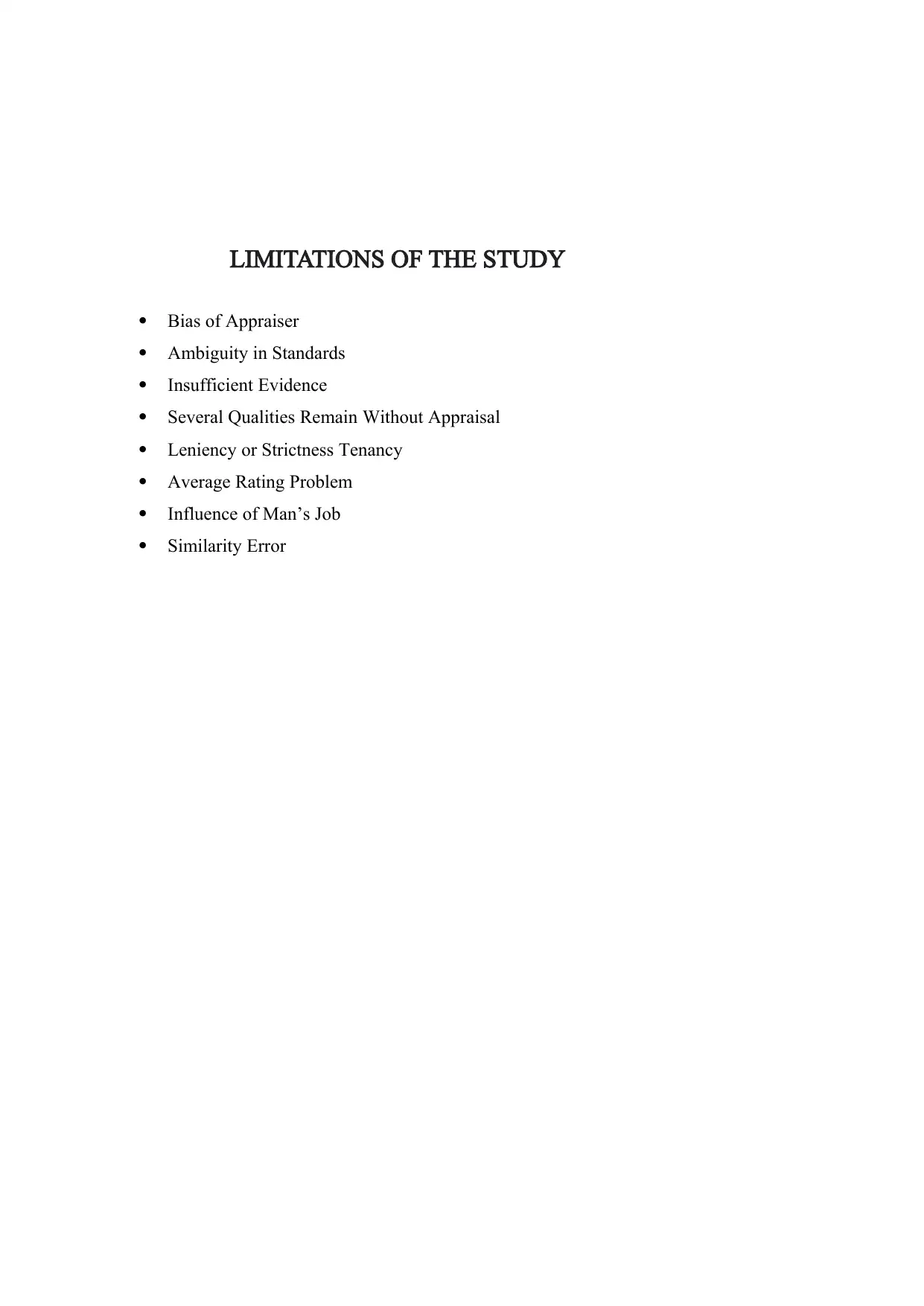
LIMITATIONS OF THE STUDY
Bias of Appraiser
Ambiguity in Standards
Insufficient Evidence
Several Qualities Remain Without Appraisal
Leniency or Strictness Tenancy
Average Rating Problem
Influence of Man’s Job
Similarity Error
Bias of Appraiser
Ambiguity in Standards
Insufficient Evidence
Several Qualities Remain Without Appraisal
Leniency or Strictness Tenancy
Average Rating Problem
Influence of Man’s Job
Similarity Error

INDUSTRY PROFILE
The Indian automobile industry has historically been a good indicator of how well the
economy is doing, as the automobile sector plays a key role in both macroeconomic
expansion and technological advancement. The two-wheelers segment dominates the market
in terms of volume, owing to a growing middle class and a huge percentage of India’s
population is young. Moreover, the growing interest of companies in exploring the rural
markets further aided the growth of the sector. The rising logistics and passenger
transportation industries are driving up demand for commercial vehicles. Future market
growth is anticipated to be fuelled by new trends including the electrification of vehicles,
particularly three-wheelers and small passenger automobiles.
India enjoys a strong position in the global heavy vehicles market as it is the largest tractor
producer, second-largest bus manufacturer, and third-largest heavy truck manufacturer in the
world. India’s annual production of automobiles in FY22 was 22.93 million vehicles.
India is also a prominent auto exporter and has strong export growth expectations for the near
future. In addition, several initiatives by the Government of India such as the Automotive
Mission Plan 2026, scrappage policy, and production-linked incentive scheme in the Indian
The Indian automobile industry has historically been a good indicator of how well the
economy is doing, as the automobile sector plays a key role in both macroeconomic
expansion and technological advancement. The two-wheelers segment dominates the market
in terms of volume, owing to a growing middle class and a huge percentage of India’s
population is young. Moreover, the growing interest of companies in exploring the rural
markets further aided the growth of the sector. The rising logistics and passenger
transportation industries are driving up demand for commercial vehicles. Future market
growth is anticipated to be fuelled by new trends including the electrification of vehicles,
particularly three-wheelers and small passenger automobiles.
India enjoys a strong position in the global heavy vehicles market as it is the largest tractor
producer, second-largest bus manufacturer, and third-largest heavy truck manufacturer in the
world. India’s annual production of automobiles in FY22 was 22.93 million vehicles.
India is also a prominent auto exporter and has strong export growth expectations for the near
future. In addition, several initiatives by the Government of India such as the Automotive
Mission Plan 2026, scrappage policy, and production-linked incentive scheme in the Indian
⊘ This is a preview!⊘
Do you want full access?
Subscribe today to unlock all pages.

Trusted by 1+ million students worldwide
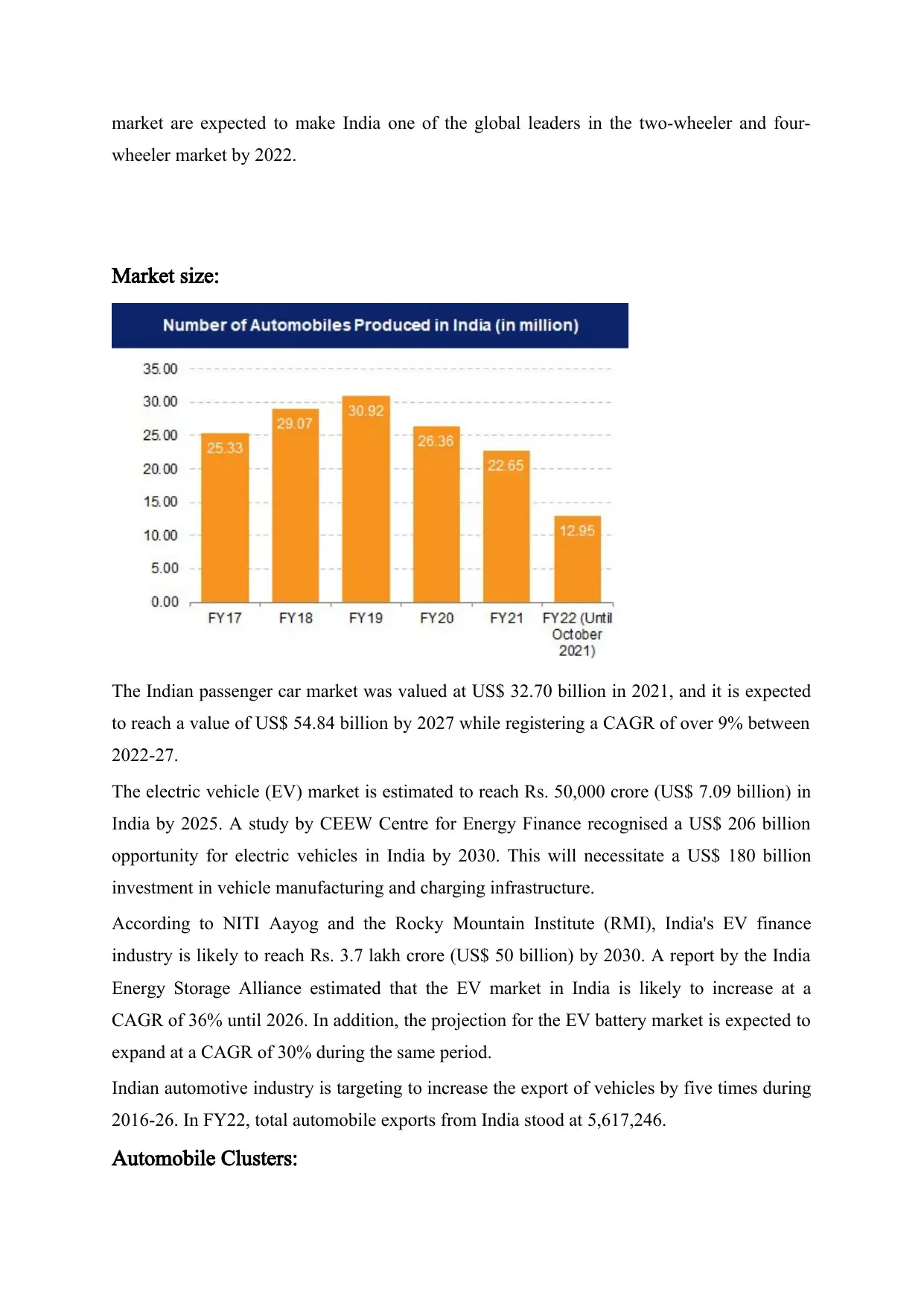
market are expected to make India one of the global leaders in the two-wheeler and four-
wheeler market by 2022.
Market size:
The Indian passenger car market was valued at US$ 32.70 billion in 2021, and it is expected
to reach a value of US$ 54.84 billion by 2027 while registering a CAGR of over 9% between
2022-27.
The electric vehicle (EV) market is estimated to reach Rs. 50,000 crore (US$ 7.09 billion) in
India by 2025. A study by CEEW Centre for Energy Finance recognised a US$ 206 billion
opportunity for electric vehicles in India by 2030. This will necessitate a US$ 180 billion
investment in vehicle manufacturing and charging infrastructure.
According to NITI Aayog and the Rocky Mountain Institute (RMI), India's EV finance
industry is likely to reach Rs. 3.7 lakh crore (US$ 50 billion) by 2030. A report by the India
Energy Storage Alliance estimated that the EV market in India is likely to increase at a
CAGR of 36% until 2026. In addition, the projection for the EV battery market is expected to
expand at a CAGR of 30% during the same period.
Indian automotive industry is targeting to increase the export of vehicles by five times during
2016-26. In FY22, total automobile exports from India stood at 5,617,246.
Automobile Clusters:
wheeler market by 2022.
Market size:
The Indian passenger car market was valued at US$ 32.70 billion in 2021, and it is expected
to reach a value of US$ 54.84 billion by 2027 while registering a CAGR of over 9% between
2022-27.
The electric vehicle (EV) market is estimated to reach Rs. 50,000 crore (US$ 7.09 billion) in
India by 2025. A study by CEEW Centre for Energy Finance recognised a US$ 206 billion
opportunity for electric vehicles in India by 2030. This will necessitate a US$ 180 billion
investment in vehicle manufacturing and charging infrastructure.
According to NITI Aayog and the Rocky Mountain Institute (RMI), India's EV finance
industry is likely to reach Rs. 3.7 lakh crore (US$ 50 billion) by 2030. A report by the India
Energy Storage Alliance estimated that the EV market in India is likely to increase at a
CAGR of 36% until 2026. In addition, the projection for the EV battery market is expected to
expand at a CAGR of 30% during the same period.
Indian automotive industry is targeting to increase the export of vehicles by five times during
2016-26. In FY22, total automobile exports from India stood at 5,617,246.
Automobile Clusters:
Paraphrase This Document
Need a fresh take? Get an instant paraphrase of this document with our AI Paraphraser
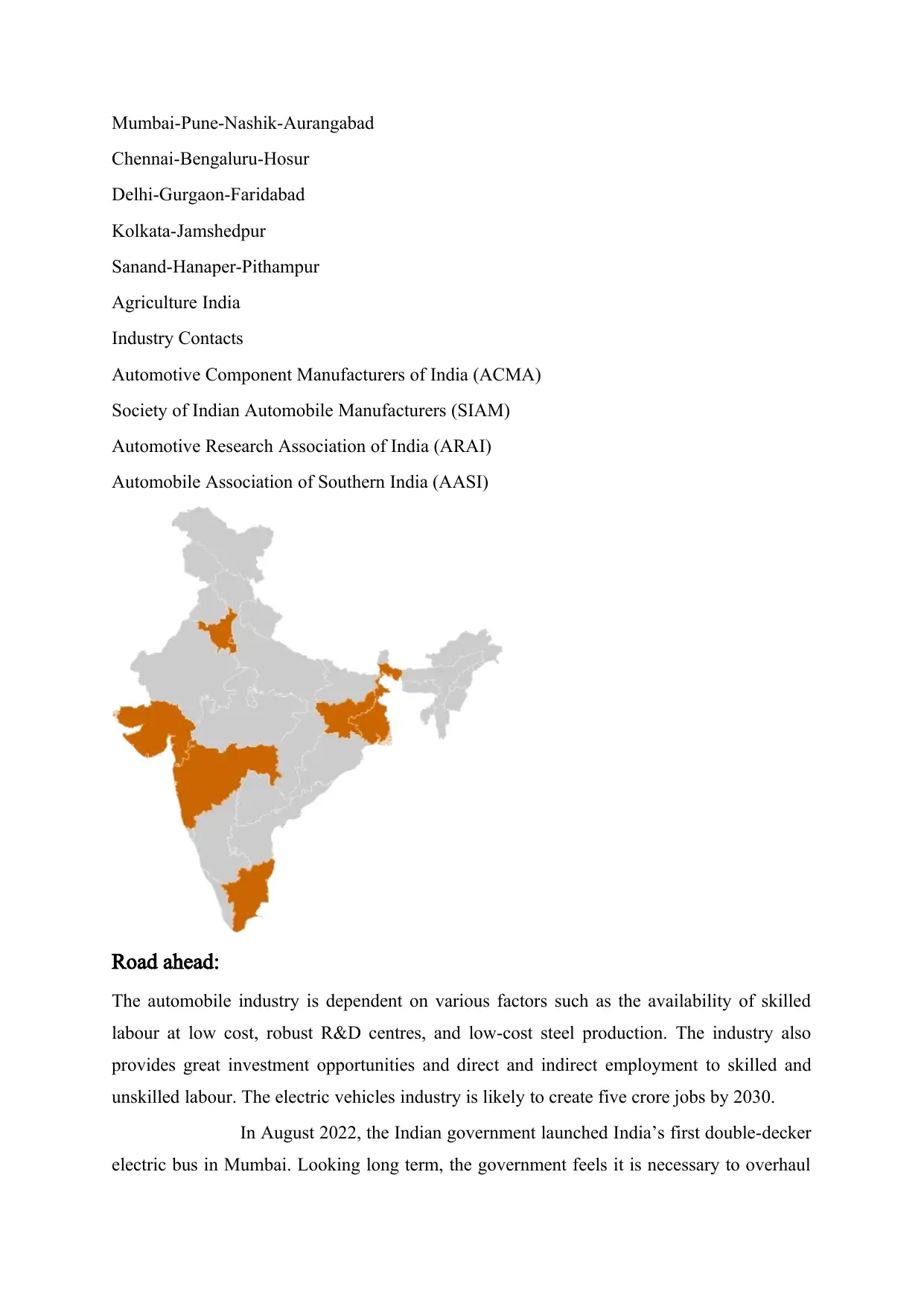
Mumbai-Pune-Nashik-Aurangabad
Chennai-Bengaluru-Hosur
Delhi-Gurgaon-Faridabad
Kolkata-Jamshedpur
Sanand-Hanaper-Pithampur
Agriculture India
Industry Contacts
Automotive Component Manufacturers of India (ACMA)
Society of Indian Automobile Manufacturers (SIAM)
Automotive Research Association of India (ARAI)
Automobile Association of Southern India (AASI)
Road ahead:
The automobile industry is dependent on various factors such as the availability of skilled
labour at low cost, robust R&D centres, and low-cost steel production. The industry also
provides great investment opportunities and direct and indirect employment to skilled and
unskilled labour. The electric vehicles industry is likely to create five crore jobs by 2030.
In August 2022, the Indian government launched India’s first double-decker
electric bus in Mumbai. Looking long term, the government feels it is necessary to overhaul
Chennai-Bengaluru-Hosur
Delhi-Gurgaon-Faridabad
Kolkata-Jamshedpur
Sanand-Hanaper-Pithampur
Agriculture India
Industry Contacts
Automotive Component Manufacturers of India (ACMA)
Society of Indian Automobile Manufacturers (SIAM)
Automotive Research Association of India (ARAI)
Automobile Association of Southern India (AASI)
Road ahead:
The automobile industry is dependent on various factors such as the availability of skilled
labour at low cost, robust R&D centres, and low-cost steel production. The industry also
provides great investment opportunities and direct and indirect employment to skilled and
unskilled labour. The electric vehicles industry is likely to create five crore jobs by 2030.
In August 2022, the Indian government launched India’s first double-decker
electric bus in Mumbai. Looking long term, the government feels it is necessary to overhaul

the country’s transportation system. It is working to create an integrated electric vehicle (EV)
mobility ecosystem with a low carbon footprint and high passenger density with an emphasis
on urban transportation reform. The government's strategy and policies are intended to
promote greater adoption of electric vehicles in response to growing customer demand for
cleaner transportation options.
The Government of India expects the automobile sector to attract US$ 8-10 billion
in local and foreign investments by 2023. India could be a leader in shared mobility by 2030,
providing opportunities for electric and autonomous vehicles.
COMPANY PROFILE
Maruti Suzuki India Limited (formerly Maruti Udyog Limited) is the Indian subsidiary
of Japanese automaker Suzuki Motor Corporation. As of September 2022, the company had a
leading market share of 42 percent in the Indian passenger car market. The company is
known for making highly reliable, low-maintenance cars for the Indian market.
Mission:
To make every journey an experience and every experience a memory, Maruti Suzuki puts
people at the centre of everything it does.
Vision:
mobility ecosystem with a low carbon footprint and high passenger density with an emphasis
on urban transportation reform. The government's strategy and policies are intended to
promote greater adoption of electric vehicles in response to growing customer demand for
cleaner transportation options.
The Government of India expects the automobile sector to attract US$ 8-10 billion
in local and foreign investments by 2023. India could be a leader in shared mobility by 2030,
providing opportunities for electric and autonomous vehicles.
COMPANY PROFILE
Maruti Suzuki India Limited (formerly Maruti Udyog Limited) is the Indian subsidiary
of Japanese automaker Suzuki Motor Corporation. As of September 2022, the company had a
leading market share of 42 percent in the Indian passenger car market. The company is
known for making highly reliable, low-maintenance cars for the Indian market.
Mission:
To make every journey an experience and every experience a memory, Maruti Suzuki puts
people at the centre of everything it does.
Vision:
⊘ This is a preview!⊘
Do you want full access?
Subscribe today to unlock all pages.

Trusted by 1+ million students worldwide
1 out of 35
Related Documents
Your All-in-One AI-Powered Toolkit for Academic Success.
+13062052269
info@desklib.com
Available 24*7 on WhatsApp / Email
![[object Object]](/_next/static/media/star-bottom.7253800d.svg)
Unlock your academic potential
Copyright © 2020–2025 A2Z Services. All Rights Reserved. Developed and managed by ZUCOL.





